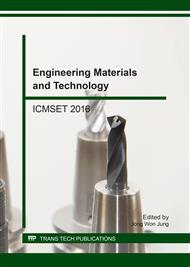p.433
p.441
p.448
p.454
p.459
p.465
p.471
p.477
p.481
Experimental Study of Inner-and-Outer Steel Flanges Subjected to Tension and Bending Loads
Abstract:
Inner-and-outer steel flange has gained many attentions in China. This type flange has both inner and outer rings, as well as bolts. To gain insight into the intrinsic characteristics of the flange, an experimental study is conducted, taking into account that the tension and bending loads are imposed simultaneously. The varying of relative displacement between two adjacent flange planes with external loading is surveyed. It is indicated that the deformation is almost linearly increased with the external loads, if there is no yielded bolt. Strain gauges are employed to capture the strain distribution in the ribs as well as the tube. The internal tension force of bolt is also measured in the test. It is revealed that the failure mode of the flange is the breaking of the outer bolts. Moreover, the existence of the tension load would reduce the bending bearing capacity of the flange, and prying force could be ignored. It is concluded that the plane-section assumption holds approximately. Accordingly, formulas are given to compute the bearing capacity of the flange. It is found that the computing method is quite conservative if the position of rotation axis takes a value of 0.8 times of the diameter of the steel tube.
Info:
Periodical:
Pages:
459-464
Citation:
Online since:
June 2017
Authors:
Price:
Сopyright:
© 2017 Trans Tech Publications Ltd. All Rights Reserved
Share:
Citation:


